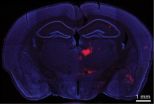Brain scans reveal how people 'justify' killing
2015-04-08
(Press-News.org) A new study has thrown light on how people can become killers in certain situations, showing how brain activity varies according to whether or not killing is seen as justified.
The study, led by Monash researcher Dr Pascal Molenberghs, School of Psychological Sciences, is published today in the journal Social Cognitive and Affective Neuroscience.
Participants in the study played video games in which they imagined themselves to be shooting innocent civilians (unjustified violence) or enemy soldiers (justified violence). Their brain activity was recorded via functional magnetic resonance imaging (fMRI) while they played.
Dr Molenberghs said the results provided important insights into how people in certain situations, such as war, are able to commit extreme violence against others.
"When participants imagined themselves shooting civilians compared to soldiers, greater activation was found in the lateral orbitofrontal cortex (OFC), an important brain area involved in making moral decisions," Dr Molenberghs said.
"The more guilt participants felt about shooting civilians, the greater the response in the lateral OFC. When shooting enemy soldiers, no activation was seen in lateral OFC."
The results show that the neural mechanisms that are typically implicated with harming others become less active when the violence against a particular group is seen as justified.
"The findings show that when a person is responsible for what they see as justified or unjustified violence, they will have different feelings of guilt associated with that - for the first time we can see how this guilt relates to specific brain activation," Dr Molenberghs said.
The researchers hope to further investigate how people become desensitised to violence and how personality and group membership of both perpetrator and victim influence these processes.
INFORMATION:
Dr Molenberghs is director of the Monash Social Neuroscience Lab, which studies morality, empathy and group membership in order to get a better understanding of how complex social problems such as racism and in-group bias develop.
The lab has received funding from the Australian Research Council and the Heart Foundation.
ELSE PRESS RELEASES FROM THIS DATE:
2015-04-08
Dengue is a viral infection spread between humans by Aedes aegypti mosquitoes. Dengue causes flu-like symptoms, including intense headaches and joint pains.
Published in the journal Science Translational Medicine, Professor Cameron Simmons, from the Department of Microbiology and Immunology at the University of Melbourne and the Peter Doherty Institute for Infection and Immunity, said that the discovery could lead to improved strategies to reduce the incidence of dengue.
"We did a 'real world' experiment and allowed mosquitoes infected with Wolbachia and uninfected mosquitoes ...
2015-04-08
This news release is available in German. You're up in the mountains, the snow is blindingly white, and the sun is blazing down from the sky: ideal skiing conditions - but any skiers carrying the herpes virus might also have to reckon with the onset of cold sores after their day out. Increased exposure to UV radiation releases free radicals in the body. These put the body under oxidative stress, which weakens the immune system. And that in turn allows the herpes virus to prosper.
Oxidative stress has become a major topic; not only is it implicated in many diseases, ...
2015-04-08
A new study shows that discrimination of gay and lesbian job seekers is commonplace within both private firms and the public sector in the UK.
The research, carried out by Dr Nick Drydakis of Anglia Ruskin University and published by SAGE in the journal Human Relations, involved 144 young people - all first-time job seekers - making 11,098 applications.
The study, the first of its kind ever conducted in the UK, found that gay applicants of both sexes are 5% less likely to be offered a job interview than heterosexual applicants with comparable skills and experience.
The ...
2015-04-08
(SALT LAKE CITY)--Recent research has linked the thin air of higher elevations to increased rates of depression and suicide. But a new study shows there's also good news from up in the aspens and pines: The prevalence of attention deficit hyperactivity disorder (ADHD) decreases substantially as altitude increases.
In Utah, for example, an analysis of information from two national health surveys correlated with the average state elevation of 6,100 feet showed that the rate of diagnosed ADHD cases is about 50 percent of states at sea level. In Salt Lake City, whose elevation ...
2015-04-08
DURHAM, N.C. - An estimated 9 percent of adults in the U.S. have a history of impulsive, angry behavior and have access to guns, according to a study published this month in Behavioral Sciences and the Law. The study also found that an estimated 1.5 percent of adults report impulsive anger and carry firearms outside their homes.
Angry people with ready access to guns are typically young or middle-aged men, who at times lose their temper, smash and break things, or get into physical fights, according to the study co-authored by scientists at Duke, Harvard, and Columbia ...
2015-04-08
Amsterdam, The Netherlands, April 8, 2015 -- Non-alcoholic fatty liver disease (NAFLD) is the most common cause of chronic liver disease in the western world. A new study published in the Journal of Hepatology shows that exercise, regardless of frequency or intensity, benefits obese and overweight adults with NAFLD.
NAFLD is considered the hepatic manifestation of metabolic syndrome and is commonly associated with obesity and diabetes. There are no approved drug treatments for NAFLD, but lifestyle interventions such as diet, exercise, and the resulting weight loss have ...
2015-04-08
A July, 2014 Call to Action to Prevent Skin Cancer by acting Surgeon General Dr. Boris Lushniak points out that indoor tanning is "strongly associated with increased skin cancer risk," but stops short of reporting that tanning causes cancer. A University of Colorado Cancer Center opinion published today in the American Journal of Preventive Medicine points out that UV tanning meets the same criteria as smoking as a cause of cancer and argues that announcing the causality could save lives.
"In 1964 when the Surgeon General finally reported that smoking causes lung cancer, ...
2015-04-08
The secret communication of gibbons has been interpreted for the first time in a study published in the open access journal BMC Evolutionary Biology. The research reveals the likely meaning of a number of distinct gibbon whispers, or 'hoo' calls, responding to particular events and types of predator, and could provide clues on the evolution of human speech.
While lar gibbons (Hylobates lar) are mainly known for their loud and conspicuous songs, they can also produce a number of soft call types known as 'hoo's. These subtle calls have been alluded to in studies dating ...
2015-04-08
Life has adapted to all sorts of extreme environments on Earth, among them, animals like the deer mouse, shimmying and shivering about, and having to squeeze enough energy from the cold, thin air to fuel their bodies and survive.
Now, in a new publication in the journal Molecular Biology and Evolution, Scott, Cheviron et al., have examined the underlying muscle physiology from a group of highland and lowland deer mice. Deer mice were chosen because they exhibit the most extreme altitude range of any North American mammal, occurring below sea levels in Death Valley to ...
2015-04-08
Cold Spring Harbor, NY - The prefrontal cortex (PFC) plays an important role in cognitive functions such as attention, memory and decision-making. Faulty wiring between PFC and other brain areas is thought to give rise to a variety of cognitive disorders. Disruptions to one particular brain circuit--between the PFC and another part of the brain called the thalamus--have been associated with schizophrenia, but the mechanistic details are unknown. Now, Cold Spring Harbor Laboratory scientists have discovered an inhibitory connection between these brain areas in mice that ...
LAST 30 PRESS RELEASES:
[Press-News.org] Brain scans reveal how people 'justify' killing


